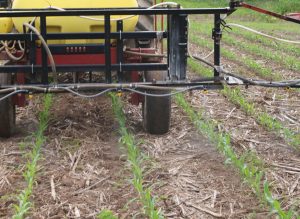Dr Rakesh S. Chandran – Sustainable Weed Coexistence in Corn Crops
Agricultural weeds have the potential to cause significant crop loss. As such, conventional weed management practices have aimed to keep crop fields free from weeds through the broad application of herbicides. However, these practices have damaging consequences on the surrounding environment. Dr Rakesh Chandran and his team in the Agriculture and Natural Resources Department of West Virginia University have developed a more sustainable herbicide application regime that allows weeds to coexist with corn crops at acceptable levels, with the aim of improving environmental health without significantly sacrificing crop yield.
Defining ‘Weeds’
What is a weed? Ask this question and you may get a variety of answers, depending on who you are speaking to. While many plants considered ‘weeds’ have similar characteristics, such as fast growth or high seed production, there is no single botanical classification for weeds. Instead, weeds are simply plants growing anywhere that they interfere with human activity, including gardens, lawns, and crop fields.
For farmers, weeds have the potential to significantly reduce crop yields by competing with cultivated plants for water, space, nutrients and light. Herbicide use to control weeds has helped agriculture to keep up with the food requirements of a growing human population, but this practice is under increasing scrutiny due to its undesirable side-effects. For instance, the widespread application of herbicides leads to vast swathes of land where the cultivated crop is the only plant species present. Such monoculture plantations contribute to the decline of beneficial animals and plants that provide valuable ‘ecosystem services’ – such as pollination, nutrient recycling, carbon storage, and pest insect control.
In the absence of other plants, soil left exposed immediately after crop harvest and before weed coverage is at risk of erosion and increased water and nutrient run-off into surrounding natural water systems. In addition, agricultural chemicals used for crop protection and plant nutrition frequently find their way into the surrounding environment, damaging or creating imbalances in fragile ecosystems and negatively impacting non-target plant and animal species.
Finally, the repeated application of herbicides has led to the emergence of herbicide resistance in many weed species, posing a significant risk to the continued efficacy of these conventional practices. While employing mixtures of multiple chemicals could further aggravate herbicide resistance, farmers in the state of Georgia have been able to manage resistant weeds through careful recruitment of Integrated Pest Management (IPM) practices. Indeed, IPM practices that balance the need for maintaining yields and reducing costs, while also preserving the natural environment are gaining popularity with farmers, governments and consumers.
Dr Rakesh Chandran and his colleagues at West Virginia University have been exploring alternative weed management techniques in corn cultivation, which are based on allowing acceptable levels of weeds to coexist with cultivated crops. The team aims to develop sustainable practices that maintain crop quality and yield, while being gentler on the surrounding ecosystems and alleviating the threat of herbicide resistance.

Conventional Weed Management in Corn
Cultivated corn, of the species Zea mays, is one of the most economically important crops across the world. It is an essential food staple in many areas, for both humans and livestock, and is used in the production of biofuels and other products. As such, vast areas of land are devoted to its production. ‘In the USA alone, over 37 million hectares of land is dedicated to cultivating corn – an area larger than the UK and Ireland combined – amounting to billions of US dollars in annual revenue,’ says Dr Chandran.
Weeds competing with young corn plants, especially in the first few weeks of growth, have the potential to cause significant losses in crop yield and quality. Conventionally, farmers have neutralised this threat by applying herbicides across entire corn fields to achieve complete weed control. With the advancement of agricultural machinery allowing farmers to cover large areas of fields in short periods, herbicides applied in this ‘broadcast’ fashion are a relatively cost-effective strategy to control weeds.
However, as discussed above, such broadcast application of herbicides is not the most sustainable or environmentally sound solution. Dr Chandran hypothesised that if left to grow in the space between rows of corn, wild plants – the ‘weeds’ – may not reduce corn yields significantly and could increase the floral biodiversity of cornfields, which in turn would provide valuable ecosystem services.
‘In the USA alone, over 37 million hectares of land is dedicated to cultivating corn – an area larger than the UK and Ireland combined.’

Banded Herbicide Application
Corn is typically grown in rows approximately 75 centimetres apart, leaving around 38 centimetres of unoccupied soil between the roots of plants from adjacent rows during the first growth phase. In fields where conventional broadcast herbicide application is used, this area is kept free from weeds. Dr Chandran’s team developed a ‘banded’ herbicide application technique, in which only the area directly around the young corn plants were treated, leaving untreated bands of freely growing weeds between the corn rows.
To determine the efficacy of this approach, Dr Chandran enlisted the help of corn growers in West Virginia, who were willing to provide the use of their commercial corn fields for extensive trials. ‘I carried out research over a period of five years to come up with data on corn yields as a result of applying a standard pre-mixture of herbicides, either as a conventional broadcast application or as banded application – where the herbicides were applied just over the corn rows so that weed germination to a distance of 19 centimetres on both sides is discouraged,’ he describes.
Banded herbicide application protects corn seedlings from the competing weeds during their vulnerable growth stage, while having positive effects on the overall biodiversity of the area. Dr Chandran and his team demonstrated that while fields treated with broadcast application of herbicides had biodiversity levels typical of monoculture crops, the fields treated with banded application had levels indicating ‘ecological diversity’ – meaning a high number of different species in a given area. Increasing plant biodiversity has positive consequences for other species too, such as beneficial predatory insects, and birds and mammals.
Importantly, the team’s banded herbicide treatment showed promise for maintaining similar crop yields to those achieved with broadcast herbicide application.
Overall yields were only about 8% lower (statistically insignificant) for fields treated with banded herbicide application in comparison to the broadcast application fields. However, such small losses in yields may be compensated for by the economic gains from lower herbicide usage combined with the valuable ecosystem services gained from a healthier environment.
Managing the Seed Bank
Sustainable weed control practices are gaining popularity with the public and farmers alike, but concerns over the long-term economic implications pose a major barrier to the widespread adoption of these methods.
A primary concern amongst corn growers was the potential for banded herbicide application to allow the build-up of the weed ‘seed bank’ – the number of seeds deposited into the soil. These seeds are capable of lying dormant for long periods and timing their development with the onset of favourable conditions. The sudden emergence of a large number of weeds from a stored seed bank during periods of favourable conditions may threaten to overwhelm cultivated plants and devastate entire crops.
With conventional broadcast herbicide application, weed species are fully controlled, and thus not given the opportunity to contribute to the seed bank. Dr Chandran suggests that banded herbicide application may be used in conjunction with other techniques, such as mechanical destruction of weed seeds at harvest, to counteract this problem. ‘Herbicides may be band-applied only when expected weed populations are below a certain threshold, and mechanical methods along with cultural methods, such as using cover crops, may have to be implemented to reduce the build-up of weed seed bank,’ he explains. ‘Cover crops manage biodiversity of agricultural fields, and weeds could be considered to be natural cover crops.’
Additional long-term investigations are necessary to determine the best solution for controlling the weed seed bank. ‘This is a valid concern since growers take pride in keeping fields weed-free, especially from resistant weeds such as Amaranthus palmeri, a single plant of which could produce over half-a-million seeds,’ continues Dr Chandran. ‘Growers have requested data from long-term studies under different weed population levels and weather conditions to gain confidence.’
Banded herbicide application may hold promise by encouraging a healthy dominance of wild-type weed species. However, Dr Chandran suspects it is unlikely that this practice would revert fields in regions that have become prone to resistant weeds as a result of herbicide overuse.
‘1.3 million carbon footprints can be offset annually just by using banded herbicide application in corn cultivation in the USA.’

Relative sizes of corn cobs from the broadcast plot (left) and from the banded plot (right) that caused an overall yield reduction of 8% during 5-year research.
Towards Sustainable Weed Management
The risks of using alternative practices in farming may be balanced by the benefits gained from a healthier environment. Indirect benefits from improved ecosystem services can be difficult to quantify, but estimates can be achieved for some factors. For example, the carbon captured and stored from the atmosphere by plants can help to counteract our carbon footprint – the amount of carbon produced through heating our homes, travelling, or producing our food and goods.
The researchers calculated that allowing weeds to grow freely in even just a quarter of the 37 million corn hectares in the USA would produce a total weed biomass of 11 million tonnes, based on the projected 119.2 grams of dry weeds produced in each square metre. From this, they calculated the total carbon dioxide sequestered by the weeds by multiplying the total weed biomass by 0.5 (as carbon makes up half the weight of the dry weeds) and 3.67 (to convert to CO2), to get 20 million tonnes.
‘As the carbon footprint of the average person in the USA is 15.5 tonnes, this means that 1.3 million carbon footprints can be offset annually just by using banded herbicide application in corn cultivation in the USA,’ says Dr Chandran. Thus, allowing weed species to coexist in agricultural systems may be a vital tool in the fight against climate change.
As these ecosystem services have benefits beyond the farm itself, Dr Chandran suggests that a cost-sharing program or increased farming subsidies may help to offset any losses experienced by farmers adopting more sustainable farming practices.
Conventional farming practices have focused on keeping production costs as low as possible and passing on these savings to consumers. This has resulted in relatively low-cost food options in many countries, but farming practices that sacrifice environmental health and long-term sustainability. Therefore, to future-proof our food production, the move towards sustainable farming may also require an increase in food prices. With food wastage estimated at around 40% in the USA, a greater emphasis also needs to be given to appreciating the value of food, especially food produced using more sustainable methods.
Dr Chandran’s promising research suggests that balancing affordability and sustainability is possible, but may require adjustments at every level from field to table to ensure its success. Dr Chandran and his colleagues aim to continue their investigation of alternative weed management practices and the associated ecosystem benefits. With additional work, the team hopes to improve the banded herbicide application technique further, and further quantify the benefits and costs associated with this method.
While one agricultural practice improvement alone is not enough to solve the climate crisis or halt environmental degradation, thousands of similar small adjustments in agriculture and other disciplines across the globe could cumulatively contribute to solving these problems.
Reference
https://doi.org/10.33548/SCIENTIA491
Meet the researcher

Dr Rakesh S. Chandran
Agriculture and Natural Resources
West Virginia University
Morgantown, WV
USA
Dr Rakesh Chandran earned his PhD in Weed Science from Virginia Tech, USA, before continuing his post-doctoral research at the University of Florida. He currently holds the position of Extension Specialist and Professor of Weed Science at West Virginia University (WVU), in the Department of Agriculture and Natural Resources, WVU Extension Service, and Plant and Soil Science with the Davis College of Agriculture, Natural Resources, and Design. Dr Chandran carries out an applied research and extension program to assist growers with weed management in agronomic and horticultural crops in the region. He also devotes much of his time to teaching undergraduate courses in Weed Science and coordinating West Virginia University’s Integrated Pest Management Program. Dr Chandran has authored numerous peer-reviewed publications, as well as book chapters, newsletters, fact-sheets and research reports. For his significant contributions to science, he has been the recipient of many awards and honours, including the ‘Distinguished Service Award’ from the National Association of Agricultural County Agents (NACAA) in 2016, and the ‘Gamma Sigma Delta Extension Faculty Award of Merit’ in 2018.
CONTACT
E: RSChandran@mail.wvu.edu
W: www.davis.wvu.edu/faculty-staff/directory/rakesh-chandran
KEY COLLABORATORS
Dr E. Scott Hagood (Jr), Professor Emeritus, Virginia Tech, Blacksburg, Virginia
Dr Wayne Currey, Principal Scientist, Weed Systems, Gainesville, Florida
Dr Carl Coburn, Former Undergraduate Student Intern
Mr Irwin King, Dri-Lake Farms, Charles Town, West Virginia
Mr Samuel Harper, Harper Farms, Moorefield, West Virginia
Mr Dan Foglesong, Foglesong Farms, Galispolis Ferry, West Virginia
Mr Rodney Wallbrown, Retd. County Agent, WVU Extension Service
Mr David Workman, Retd. County Agent, WVU Extension Service
Mr Craig Yohn, Retd. County Agent, WVU Extension Service
FUNDING
USDA – National Institute of Food and Agriculture
Crop Protection Chemicals donated by Syngenta Crop Protection and Bayer Crop Science
Creative Commons Licence
(CC BY 4.0)
This work is licensed under a Creative Commons Attribution 4.0 International License. 
What does this mean?
Share: You can copy and redistribute the material in any medium or format
Adapt: You can change, and build upon the material for any purpose, even commercially.
Credit: You must give appropriate credit, provide a link to the license, and indicate if changes were made.
More articles you may like
Dr Silvia Remeseiro | Mapping the Epigenetic Landscape of Glioblastoma Progression
Glioblastoma, the most aggressive form of brain cancer, continues to challenge medical professionals with its poor survival rates. Recent groundbreaking research by Dr Silvia Remeseiro and her colleagues at Umeå University in Sweden has shed light on the complex epigenetic and chromatin-related mechanisms underlying the communication between neurons and glioma cells. This research opens new avenues for understanding and potentially treating this formidable disease.
Dr Markus Stumm | Advances in Screening for Genetic Abnormalities with Non-invasive Prenatal Testing
Non-invasive prenatal testing (NIPT) is a method of screening for genetic abnormalities in the unborn child through a simple blood sample taken from the mother. The non-invasive nature of the test has minimal to no risk to the mother and foetus and, since 2012, has been applied extensively around the world. As NIPT technology advances, Dr Markus Stumm of Medicover Genetics in Germany and his colleagues from Cyprus discuss the different techniques used, their strengths, their limitations and important considerations for pregnancy management.
New Directions for Reproductive Lifespan and Healthspan
Balancing starting a family with career goals is a difficult challenge many women have to face, which can lead to inequalities in various aspects of their lives. Dr Zhongwei Huang and the team at NUS Bia-Echo Asia Centre for Reproductive Longevity and Equality (ACRLE) are pioneers in reproductive health research. They work to improve female reproductive longevity and equality, exploring novel approaches to tackle fertility and conception problems, and ways to maintain optimal healthspan later in life.
Dr Markus Regauer | An Evidence-Based Perspective on Treating Severe Ankle Injuries
Ankle injuries are very common but notoriously difficult to treat due to the complexity of the ankle anatomy, compounded by the range of surgical options available. Dr Markus Regauer, a leading orthopaedic surgeon from SportOrtho Rosenheim and Schön Klinik Vogtareuth, worked with a team of clinicians and scientists at the Musculoskeletal University Centre Munich to thoroughly review the published literature. This was combined with Dr Regauer’s extensive surgical experience to produce a practical guide for surgeons to guide the best treatment for individual ankle (syndesmotic) injuries.



